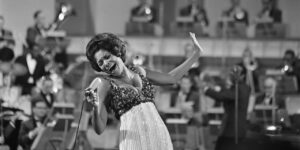Nancy Wilson

Born in Chillicothe on February 20, 1937, Nancy Wilson moved with her family to Columbus’s West Side when she was still in elementary school. After graduating from West High School, she enrolled at Central State University, with the goal of becoming a teacher. But inspired by Dinah Washington, Nancy Wilson also began singing in the same Columbus Near East Side night clubs that launched Rahsaan Roland Kirk’s career a few years earlier. That same jazz scene was so popular it drew national artists, such as Duke Ellington, Nat King Cole and a young, rising alto saxophonist, Julian “Cannonball” Adderley. The same year Adderley played on Miles Davis’s best-selling jazz album of all time, Kind of Blue, he found himself in Columbus watching Nancy Wilson perform. Adderley was enraptured. Wilson was the complete package: tall, elegant, fashion model beautiful and a mesmerizing vocalist. Adderley persuaded Wilson to move to New York City and he encouraged his record label to sign her to a recording contract. Shortly after signing with Capitol Records, Wilson released her signature classic “Guess Who I Saw Today,” a composition that has been covered by artists ranging from Keith Jarrett to current jazz vocalist phenomenon Samara Joy. Wilson’s attractiveness and charisma made her an in-demand guest for the television variety shows of the 1960s and 1970s such as the Andy Williams Show, the Smothers Brothers Comedy Hour and the Carol Burnett Show. She also guest starred on television series, including I Spy, Hawaii Five-O and Room 222. Wilson even starred in her own television variety show, The Nancy Wilson Show, winning an Emmy in 1975. Wilson won multiple Grammys and earned the highest recognition given to an artist of her genre, NEA Jazz Master, in 2004. She passed away in December 2018, less than 30 months after being recognized in the Columbus Near East Side neighborhood where her career began. Nancy Wilson was awarded a star on the Lincoln Theatre’s Walk of Fame in July 2015.